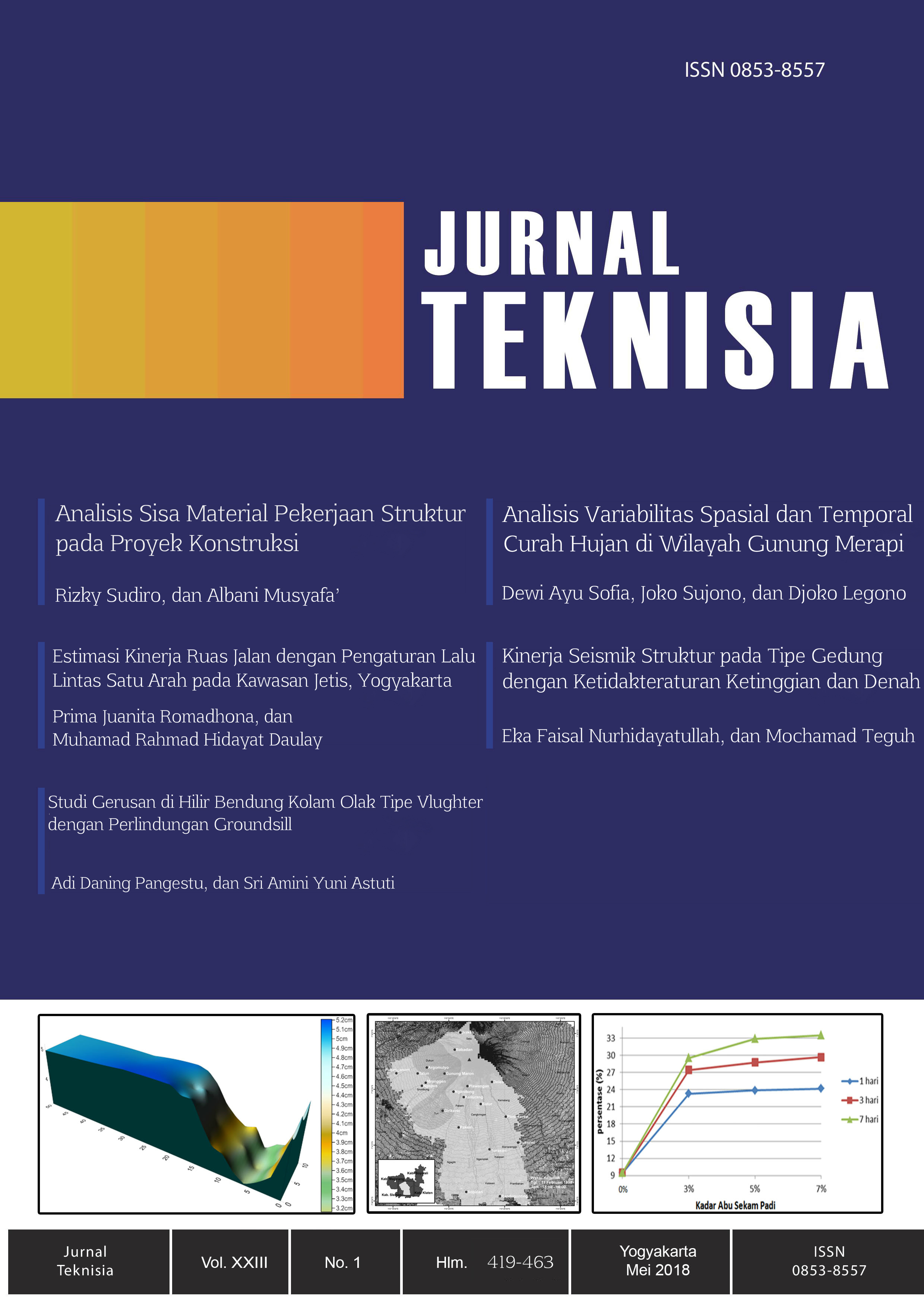Main Article Content
Abstract
Rainfall intensity is one of the main trigger factors of cold lava flow on the active volcano slope, such as Mount Merapi. In the event of cold lava flood, where the rainfall as the trigger, there is a process of transformation of rainfall into the flow. Therefore, it is necessary to analyze the characteristics of rainfall, such as variability in terms of space (spatial) and time (temporal). This is important because of Indonesia is passed by the equator, so the rainfall variability is very high. This paper will analyze the spatial and temporal variability of rainfall in the area of Mount Merapi. Rainfall spatial variability was mapped based on the results of interpolation of the maximum rainfall data by Inverse Distance Weight (IDW) method, while the temporal variability was analyzed based on the average rainfall data distribution or maximum annual rainfall of each duration by unisolated event method. The results showed that the average rainfall or maximum rainfall for duration of 1 hour - 8 hours mostly occurred in the daylight until afternoon, between the hours of 13:00 to 17:00 with the incidence of heavy rain occurred in a short duration that is on the duration of 1 hour, 2 hours , 3 hours and 4 hours. Spatial mapping results show similar pattern of distribution where the maximum rainfall position is located in the west side of Mount Merapi.
Keywords
Article Details
Under the following term:
-
Attribution — You must give appropriate credit, provide a link to the license, and indicate if changes were made. You may do so in any reasonable manner, but not in any way that suggests the licensor endorses you or your use.
-
ShareAlike — If you remix, transform, or build upon the material, you must distribute your contributions under the same license as the original.
- No additional restrictions — You may not apply legal terms or technological measures that legally restrict others from doing anything the license permits.
References
- Feng, W.C., & Chen, W.L. (2012). “Estimation of the Spatial Rainfall Distribution using Inverse Distance Weight (IDW) in the Middle of Taiwanâ€. Paddy Water Environment, Vol. 10, No. 3, pp. 209-222.
- Lu, G.Y., & Wong, D.W. (2008). “An Adaptive Inverse-Distance Weighting Spatial Interpolation Techniqueâ€. Computers and Geoscience, Vol. 34, No. 9, pp. 1044-1055.
- Moreno, J. S. F., et al. (2013) “Influence of Topography on Rainfall Variability in Santiago Island, Cape Verdeâ€. International Journal of Climatology, Vol. 34, No. 4, pp. 1087-1097.
- Ponce, V. M. (1989). Engineering Hidrology, Principle and Practices. New Jersey: Prentice hall
- Pratiwi, E. P. A., et al. (2012). “Kajian Variabilitas Curah Hujan di Kawasan Lereng Gunung Merapi dengan Uji Mann-Kendallâ€. INFO TEKNIK, Vol. 13, No. 1, pp. 1-10.
- Prayudha, D. D. (2015). “Analisis Karakteristik Intensitas Hujan di Wilayah Lereng Gunung Merapiâ€. Jurnal Rekayasa Infrastruktur, Vol. 1, No. 1, pp. 14-19.
- Sofia, D. A. (2016). “Analisis Durasi Hujan Dominan dan Pola Distribusi Curah Hujan Jam-Jaman di Wilayah Gunung Merapiâ€. Jurnal Teknologi Rekayasa, Vol. 1, No. 1, pp. 7-14.
References
Feng, W.C., & Chen, W.L. (2012). “Estimation of the Spatial Rainfall Distribution using Inverse Distance Weight (IDW) in the Middle of Taiwanâ€. Paddy Water Environment, Vol. 10, No. 3, pp. 209-222.
Lu, G.Y., & Wong, D.W. (2008). “An Adaptive Inverse-Distance Weighting Spatial Interpolation Techniqueâ€. Computers and Geoscience, Vol. 34, No. 9, pp. 1044-1055.
Moreno, J. S. F., et al. (2013) “Influence of Topography on Rainfall Variability in Santiago Island, Cape Verdeâ€. International Journal of Climatology, Vol. 34, No. 4, pp. 1087-1097.
Ponce, V. M. (1989). Engineering Hidrology, Principle and Practices. New Jersey: Prentice hall
Pratiwi, E. P. A., et al. (2012). “Kajian Variabilitas Curah Hujan di Kawasan Lereng Gunung Merapi dengan Uji Mann-Kendallâ€. INFO TEKNIK, Vol. 13, No. 1, pp. 1-10.
Prayudha, D. D. (2015). “Analisis Karakteristik Intensitas Hujan di Wilayah Lereng Gunung Merapiâ€. Jurnal Rekayasa Infrastruktur, Vol. 1, No. 1, pp. 14-19.
Sofia, D. A. (2016). “Analisis Durasi Hujan Dominan dan Pola Distribusi Curah Hujan Jam-Jaman di Wilayah Gunung Merapiâ€. Jurnal Teknologi Rekayasa, Vol. 1, No. 1, pp. 7-14.
